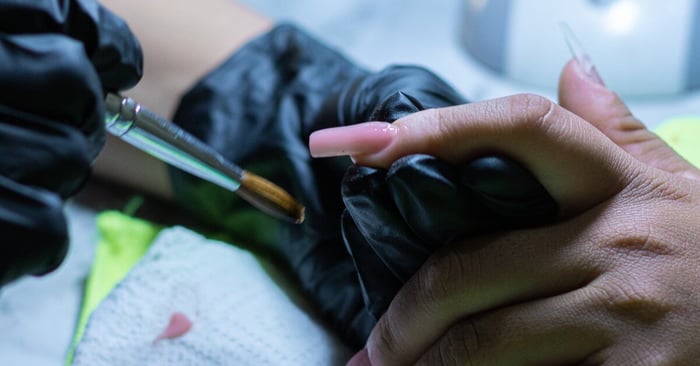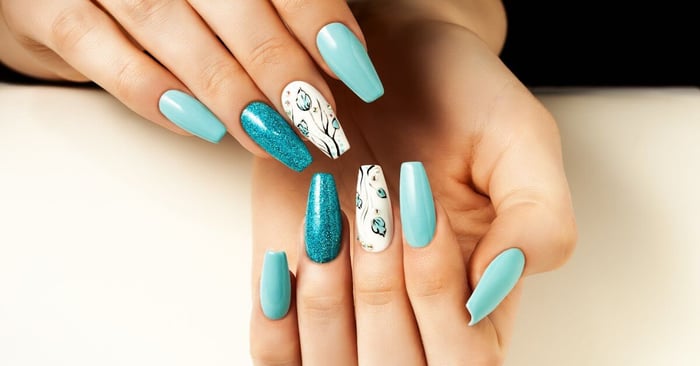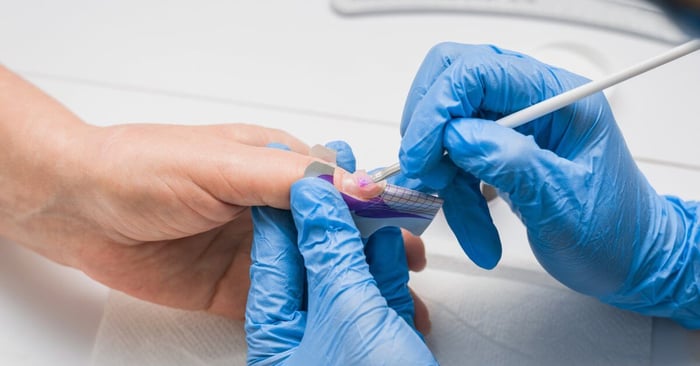Nail studios usually offer various types of manicures, including traditional polish, gel, and acrylic nails. Understanding how essential products such as liquid monomers work can help ensure the safety and quality of your nail service. This blog explains the science and process behind liquid monomers, focusing on their structure, reactivity, and usage in nail care.
Exploring Key Terms
Before we can get into the specifics of liquid monomers, let’s define some key terms that you’ll frequently encounter in nail care:
Liquid Monomers
Liquid monomers are substances that interact on a molecular level to create durable and aesthetically pleasing nail enhancements. The most commonly used liquid monomer in nail enhancements is ethyl methacrylate (EMA). Liquid monomers can be odorless or have a strong, chemical-like scent that some clients may find unpleasant.
Pro Tip
Brands such as Mia Secret sell many liquid monomers, including scent options. Monomers with a slight fragrance reduce chemical odors, which can increase client experience.
Polymers
Polymers are long chains of repeating molecules that form the solid structure of artificial nails. In nail enhancements, a liquid monomer solution suspends polymer particles until they bond to form a solid material.
Reactivity
The reactivity of a liquid monomer refers to its ability to bond with other substances. In nail care, high reactivity is ideal since it allows for better adhesion and creates stronger and more durable nails.
The Science Behind Liquid Monomers

Now that we’ve defined liquid monomer, let’s dive into how it works. The underlying chemical reactions must occur properly for liquid monomers to function as intended. Achieving the right mixture and adequately applying it requires a solid understanding of the science behind liquid monomers.
Molecular Structure and Reactivity
A liquid monomer is a single molecule characterized by its reactive sites. These areas allow monomers to chemically bond with each other, forming long, chain-like structures known as polymers. This transformation happens through a chemical process that converts the liquid into a solid state.
Manufacturers carefully engineer the reactivity of liquid monomers to ensure optimal bonding and durability. Mixing the liquid monomer with a powder catalyst initiates the chemical reaction, which creates the solid material that forms acrylic nails.
The Chemical Reaction Process
When you mix liquid monomers with polymer powder, a polymerization process initiates. This process involves the activation of reactive sites, where neighboring monomer molecules connect, creating a solid structure over time. The combination of the liquid monomer and the powder forms a paste that you can use to sculpt into the desired nail shape.
Pro Tip
Proper mixing ratios are essential to achieve the ideal consistency and ensure a smooth application. Too much liquid can cause the mixture to run, while too little can make the paste brittle and challenging to work with.
Role of Catalysts in Speeding Up the Reaction
Catalysts are integral to the polymerization process. In chemistry, a catalyst is a substance that accelerates the rate of a chemical reaction without undergoing any change. In nail care, we usually refer to catalyst substances as “activators” because they speed up the curing process of the monomer and polymer mixture.
For nail care, catalysts ensure that the mixture transitions from paste to hardened nails within a manageable timeframe. Without a catalyst, the process would take significantly longer, resulting in suboptimal curing. Benzoyl peroxide is a commonly used catalyst in liquid monomers for nail enhancements due to its ability to interact efficiently and predictably with the other components.
The Process of Using Liquid Monomer
When it comes to the science behind liquid monomers, you have to follow specific steps to achieve the desired results; the chemical reaction may not work if you fail to adhere to these procedures. Before applying the polymer mixture, you’ll want to prepare the nail surface for acrylics by cutting and shaping the nails, pushing back cuticles, and lightly buffing the natural nail.
Once you’ve prepared the nail surface, it’s time to get started.
Mix Polymer Powder With Liquid Monomer
When you mix the polymer powder with the liquid monomer, you initiate a chemical reaction to form a hard substance. The mixture should have a creamy consistency that is not too runny or dry. It’s usually best to use a 1:3 ratio of liquid monomer to polymer powder; however, all products may vary, so refer to the manufacturer’s instructions for proper mixing ratios.
Sculpt and Shape
Using a brush, apply the mixture to your nail surface and shape it as desired before it hardens. Working quickly but carefully during this step is essential, as the mixture will harden within minutes.
Talk to your client about the design they want beforehand so that you can plan your technique accordingly. As you trim and shape the acrylic, show the client your progress so that they can give feedback and make adjustments if needed.
Allow for Curing
The paste begins to harden as the monomers polymerize. While the timing and reaction speed depend on the presence of a catalyst and the environment, the process typically takes several minutes. During this period, carefully smooth out inconsistencies to achieve a seamless appearance. Once hardened, the nail enhancements become durable with a natural-looking finish.
Tips for Using Liquid Monomer

Like any nail enhancement application, perfecting the use of liquid monomers takes practice. Keep our tips in mind when working with them.
Prioritize Safety
When working with liquid monomers, you should always wear gloves and maintain a well-ventilated area. Direct contact with the skin can cause severe irritation, and inhaling fumes can harm your respiratory system.
Maintain Proper Ratios
Using the correct ratio of liquid monomer to polymer powder is crucial for achieving optimal results. Too much or too little of either component can result in an inconsistent product. For example, too much liquid can lead to poor adhesion or sculpting of the acrylic, while too little can cause cracking or brittleness once cured.
Store Properly
Liquid monomers can be sensitive to temperature and light, so storing them in a cool, dark place is essential to maintain their quality. Doing otherwise could cause the monomers to cure prematurely, leading to difficulties during application.
Use Quality Products
Investing in high-quality liquid monomers and polymer powders is crucial for producing long-lasting and aesthetically pleasing nail enhancements. The products you use should reflect your standards as a professional and contribute to your client base’s overall satisfaction.
At Mia Secret, you can stock up on different liquid monomer and polymer powder options to cater to each client’s specific needs. Your nail salon can thrive and offer top-notch nail care services with the best products.

